1974 United States Grand Prix race report
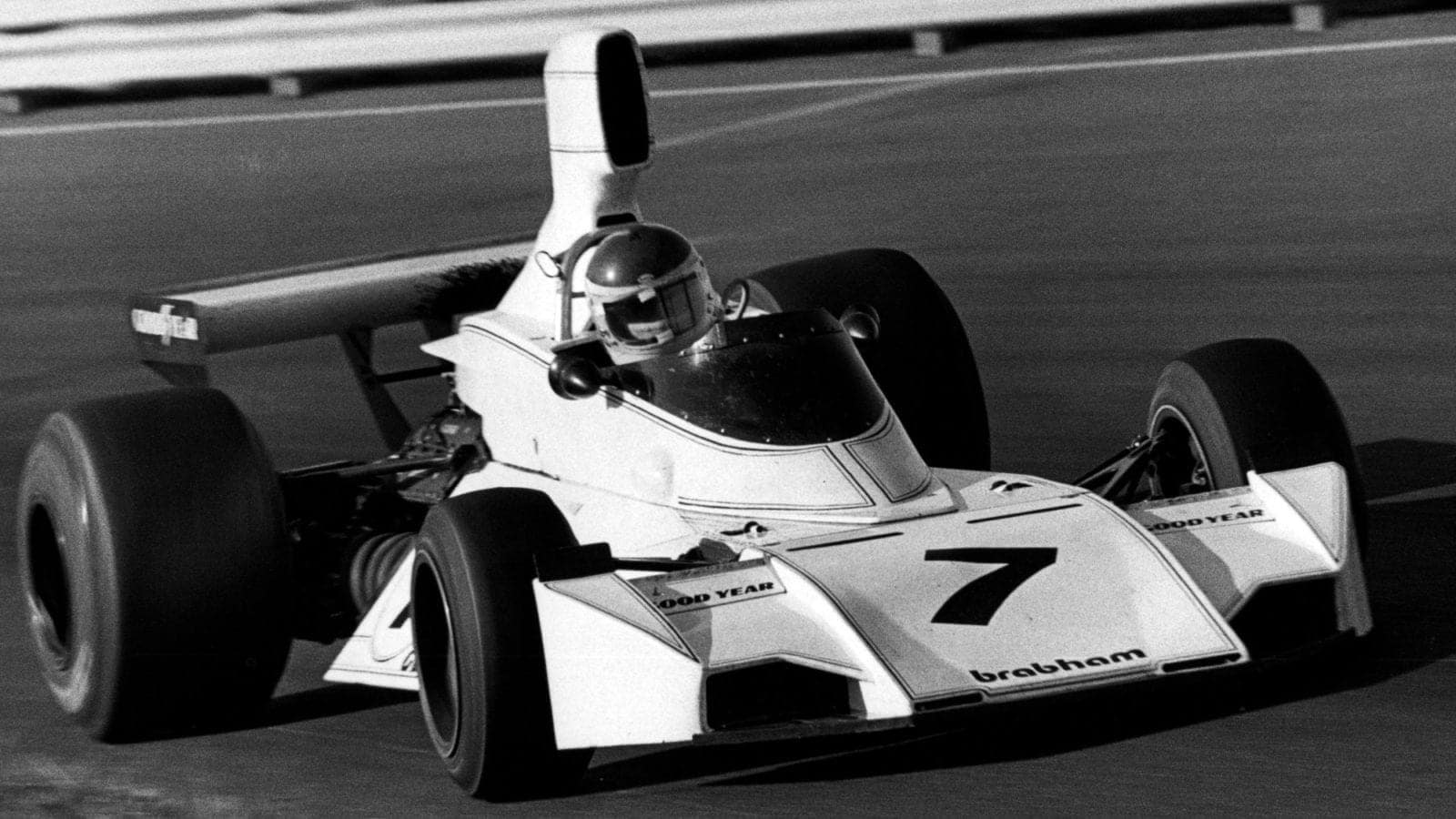
Carlos Reutemann on the way to his win
Bernard Cahier/Getty Images
Reutemann the Winner, but Fittipaldi the Champion
Watkins Glen, New York, October 6th
Watkins Glen, the 3.7-mile road circuit in the north of New York state, has been the scene of the World Championship’s final round ever since 1971, the Mexican Grand Prix having been dropped from the calendar that year. This year there was added interest attached to the United States Grand Prix, for this was the event which would decide both the drivers’ World Championship as well as the constructors’ title and most of the cars which had been present at the Canadian Grand Prix stayed in North America for the second race.
Such was the intensity of competition at Watkins Glen, this intensity fostered by the added attraction of a first prize totalling 50,000 dollars, that many teams took the opportunity to test at the circuit during the two-week break between races. However, an unexpected bout of cold weather a couple of days before the start of official practice made it seem as though the race might have to be cancelled, but fortunately sunny skies and higher temperatures returned before the serious business got under way.
Last year Ronnie Peterson led the United States Grand Prix from start to finish, so his Lotus 721R8 looked as though it would be a suitable mount for a second year running, Particularly after his impressive showing at Mosport Park. Ickx handled 72/R5 as usual, while a third entry was made for the former Brabham and Surtees Formula One driver Tim Schenken who has had a bleak season this year driving the Ron Tauranac-designed Trojan-Cosworth T103. Schenken was assigned to the Lotus 76/JPS 9 on condition that he would have to give the car up to Peterson should the Swede damage his 72 or suffer some last-moment mechanical failure.
Elf Team Tyrrell had been busy preparing 007/2 for Scheckter to drive, this car having been flown out from the team’s Ripley headquarters to replace 007/3 which sustained very serious damage in the Mosport Park accident. The fresh car was fitted with slightly larger fuel tanks, for the Watkins Glen race, at just over 199 miles, is one of the longest Grands Prix of the season and with Scheckter retaining an outside chance of winning the World Championship, Tyrrell wasn’t going to take any chances. This longer-range tankage had originally been built into Depailler’s new car (007/4), but the spare chassis (007/1) retained its original fuel capacity.
Four McLaren M23s came to Watkins Glen, all having appeared at Mosport Park. These were M23/8 for Firtipaldi, M23/6 for Hulme, M23/4 for Mass and M23/5 as a spare chassis which in fact didn’t get used by either driver all weekend. This event was going to be Hulme’s last, for the craggy New Zealander had decided to retire from motor racing after the United States Grand Prix although he was not destined to make his decision public until the following Monday.
Bernie Ecclestone’s Brabham team had BT44/1 on hand for Reutemann and BT44/2 for Pace, while John Watson’s BT44/4 was successfully repaired following the damage it sustained to the underside of its monocoque when it slid off the circuit at Mosport Park. All three 1974 Brabhams were completely unchanged and they were backed up by Ashley in Watson’s old BT42/2 who was trying for the last time this year to get to grips with Formula One.
A totally new monocoque had been required for Vittorio Brambilla’s March 741, but the rebuild was successfully completed after a great deal of hard graft on the part of his team’s mechanics who have a lot of time for the plucky Italian as he is not in any way averse to rolling his sleeves up and giving them a hand. Stuck drove the second car as usual although he had a rather hectic schedule in the intervening ten days since Mosport, rushing back with Depailler to drive against each other at an F2 event at Hockenheirn. Similarly, in the BRM and Shadow team Beltoise, Jarier and Pryce had all been home to Europe for another race but rushed back in time to practise BRM P201/03, Shadow DN3/2A and DN3/3A respectively. Chris Amon was down to have his second drive as a member of the Bourne organisation and although he had been singularly unimpressed with his car’s performance in the Canadian Grand Prix, he was at least happy to know that an engine mounting was found to have broken so the apparent handling deficiency was not just in his mind.
In the Surtees team, Koinigg continued to drive TS16/03-3, but Derek Bell’s place in the second car was taken by Jose Dolhem, the French driver who tried unsuccessfully to qualify at both Dijon-Prenois and Monza. Merzario and Laffite were representing the Williams team as usual, Wilds drove Morris Nunn’s Ensign and Rolf Stommelen rounded off the season as “temporary” team-mate to Graham Hill in the Embassy Lola T370. Having finished second in the Hesketh March 731 last year, James Hunt was hoping for great things from the Hesketh 308/2 complete in the same side radiator trim which took him to fourth place at Mosport and the team bought along 308/3 as a reserve car once again.
Undoubtedly the most popular entries in the race as far as the American crowd was concerned, Mario Andretti and Mark Donohue were taking part in their home Grand Prix in the Parnelli VPJ1 and the Penske PC1 for the very first time. Both cars had taken part in the pre-practice test sessions at Watkins Glen and each team felt confident that it could improve on its Mosport Park result. Finally, the one team with a chance of beating Fittipaldi and McLaren Racing to the World Championship, Ferrari, had run into a host of problems whilst testing the previous week. Regazzoni had crashed 312B3/016 very heavily and completely written the car off against the guard rail but the Swiss was fortunate to escape from the wreckage with an uncomfortably bruised leg.
The damaged Ferrari was flown home to Italy and the Maranello works had to put in many extra hours getting 011 ready to be dispatched to the United States as a replacement, this unfortunate incident interrupting the development work which was being carried out on the revised 312T model which features a transverse gearbox cast into the back of the engine block amongst other refinements and was to have been tested in Italy the week after Watkins Glen.
Qualifying
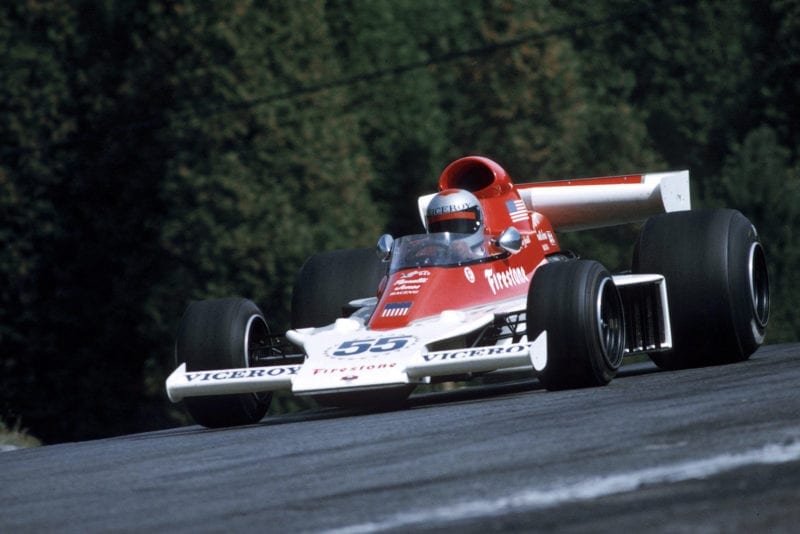
Mario Andretti improved 3rd on the grid after qualifying 16th last time out
Motorsport Images
Official practice took place on the Friday and Saturday prior to the race, it being apparent from the word go that everyone was working as hard as they possibly could to secure a decent grid position. The “heroes” were looking as heroic as ever, the “triers” were trying probably harder than ever before this year and the “also rans” were even looking quick for a change as they all strove to get a place on the last Grand Prix grid of this season. Unfortunately BRM were in trouble almost before the session was under way with Beltoise crashing his P201 on an uphill right-hand corner on the new section of the circuit after trying too hard too early on cold tyres and a filthy dirty track surface. The little Frenchman escaped from the twisted BRM with a slightly chipped bone in his ankle, but neither the mechanics nor Tim Parnelli looked particularly pleased with Beltoise because he ought to have known better than to go so fast so quickly on very cold tyres.
Whilst all this drama was being enacted in the BRM pit, Carlos Reutemann was busy underlining the fact that his Brabham BT44 is one of the best Grand Prix cars currently racing by lapping in 1 min. 39.26 sec. which topped the practice lists until Andretti went 0.01 sec. faster in the afternoon. The Italian-born American made his Formula One debut at Watkins Glen back in 1968 at the wheel of a Lotus 49 and he put it on pole position, a fact which raised a few eyebrows at the time. Since then he has concentrated on American USAC events and only had intermittent races in Europe with Formula One Marches and Ferraris. However, it has always been one of his ambitions to go back into Formula One with an American team and, albeit with a car designed by an Englishman, that is just what he has done and the whole demeanour surrounding the Parnelli team at Watkins Glen was very similar to that surrounding Ferrari at Monza, or that which used to surround the Matra-Simca team at the French Grand Prix. It was a contagious feeling of confidence and by the end of the first day, everyone in the team from Parnelli Jones and sponsor Vel Miletich right down to the most junior mechanic was grinning fit to bust.
It seemed that the first practice hurdle to clear was the 1 min. 40 sec. barrier, this being successfully managed by Andretti, Reutemann, Scheckter, Pace, John Watson and the two Ferraris. But even though the Italian cars were near the front all was far from well as both drivers were complaining that their cars understeered acutely and Lauda’s was ruining its rear shock-absorbers at a very fast rate. Out on the circuit the red cars’ familiar stability had vanished and both their drivers wrestled hard with the Ferraris as they weaved disconcertingly under braking and their rear ends vibrated violently under harsh acceleration.
Lauda’s best ended up as 1 min. 39.32 sec. while Regazzoni just slipped in a 1 min. 39.73 sec. lap when the engine of his car blew a hole in its crankcase. So that was that. Nevertheless, Ferrari could perhaps draw some small consolation from the fact that Team Lotus were having one of their most shambolic weekends since they dropped the Lotus 76 project. Peterson looked depressed, Ickx merely resigned to the fact that neither of them could cure the two Lotus 72s of their massive understeer problem and although Ickx just broke into the 1 min. 40 sec. barrier, the usually cheerful Swede was very glum after failing to break 1 min. 41 sec. This air of gloom quickly spread through the team for one of the really good things about having a driver like Peterson in the team is that he tries hard all the time, so you don’t have to bother about wondering “Is he having an off-day?”. Everyone could see that Peterson was trying as hard as he knew to get the car going well, so there was only one conclusion to be drawn and that was that the fault lay with the car. This was underlined on the second day when he lapped appreciably quicker than his team mate, and the grim sight of the two Lotus 72s lining up on the starting grid in 16th and 19th position out of 25 cars was very depressing for Colin Chapman. Just to complete their anguish, Schenken failed to qualify the spare 76.
Emerson Fittipaldi encountered braking problems with M23/8 which necessitated his mechanics stripping down the front brakes on the spare McLaren and transferring the discs to the Brazilian’s regular car. Once that was carried out, Fittipaldi recorded a 1 min. 39.85 sec. lap which stood him in good stead at the front of the grid. Hulme wore a relaxed, unconcerned look on his face while Mass, in contrast, didn’t understand why he couldn’t get the Yardley car going faster than he did. Penske’s team were learning all about Formula One the hard way as they spent most of Friday’s session attempting to come to terms with a mysterious misfire on Donohue’s car. After trying every remedy they could think of, they were all a little bit perplexed and embarrassed to find that the battery had a loose earth lead. Despite this trivial fault, at least the Penske team is following the Parnelli team up the grid and passing a lot of seasoned regulars as they do so.
After a rather pointless demonstration race by three UOP Shadow Can-Am cars, won by George Follmer, Saturday’s session got underway with Reutemann establishing fastest time in his Brabham. The way in which this swarthy Argentinian has come to the fore and developed his driving ability this year is quite outstanding. Last year he was never quite as determined in the Brabham BT42, but this year, with Gordon Murray’s BT44, he has developed into an impressive driver. He recorded an excellent 1 min. 38.97 sec. lap to take pole position for the 59 lap race and never looked as though he was having to work hard to do so. Alongside him on the front row of the grid sat James Hunt in the Hesketh after a fine 1 min. 38.99 sec. which was aided by the excellent tyres produced by Firestone’s Akron, Ohio factory for their last major international event. This was the first time Hunt had managed to put the Hesketh onto the front row of a Grand Prix grid and provided a degree of consolation for the English team who expected to do so well this year and ended up having a rather disappointing season.
Andretti was all set to retain his place at the front of the grid on Saturday afternoon, but he spun at the same corner which had claimed both Beltoise and Regazzoni. The Parnelli revolved a couple of times and the American was unfortunately unable to prevent his car hitting the guard rail with a front wheel, slightly bending the suspension and steering. Practice was halted as the damaged car was towed back to the pits and, although the entire Parnelli team fell on the car and worked like slaves to repair it in order to continue practising, Andretti only made it back out onto the circuit with just over five minutes left to go. This meant that he was unable to improve on his Friday time, so he faced the start from the second row of the grid alongside Pace’s Brabham which had recorded 1 min. 39.28 sec.
On the inside of the third row, Niki Lauda was flanked by Scheckter in Tyrrell 007/2 although his time had been established in 007/1 after an engine had failed in his newer car while John Watson’s speed in the brown Hexagon car was repaid with a grid time quicker than Emerson Fittipaldi, the Brazilian not being unduly worried by this because he was ahead of Regazzoni on the grid and realised full well that he was in the strongest position as far as the outcome of the World Championship was concerned. Two rows behind Fittipaldi there was a great “A for effort” award earned by Chris Amon who had been driving the BRM “on its doorhandles” so to speak to record 1 min. 40.7 sec. although it was very difficult to decide whether this was more meritorious than Laffite’s 1 min. 40.59 sec. which put the Frenchman’s Williams-Cosworth ahead of the BRM one place.
On the seventh row of the grid were Depailler, feeling crestfallen on 1 min. 40.7 sec. and Donohue, feeling encouraged, on 1 min. 40.8 sec. Behind this “centre point” of the grid things were much as usual with one or two major upsets. Neither of the Lotus 72s should have been down in the positions they were, but things failed to improve for them on Saturday, Pryce and Mass were rather disappointing while both the Lolas were slow perhaps understandably in this case for Stommelen’s last visit to Watkins Glen ended with minor burns after a serious accident in the Alfa Romeo T33/12 and Hill’s car blew two DFVs during the course of practice. Ir was nice to see that Mike Wild’s persistence in the Ensign had paid off and he managed to gain a place on the grid ahead of Koinigg, Hill and Brambilla, the last-named having a slight brush with a barrier in the final session and slightly damaging the March’s monocoque. Dolhem ended up as first reserve, just as he had been at Monza, while Schenken, Stuck, Ashley and Beltoise were the others who failed to get a place at the start.
Race
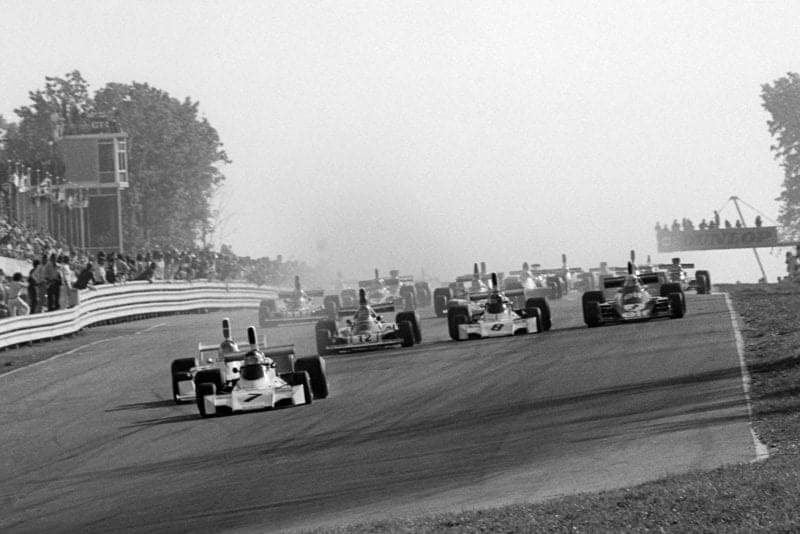
The field races down to Turn 1
Motorsport Images
Sunday’s untimed “warming up” session brought last-moment problems for several teams; Hunt’s Hesketh stopped on the circuit with fuel pressure problems, Laffite’s Williams broke a wheel stud and Andretti’s car ran into a bout of misfiring which was traced to the electrical system. However, some feverish work by the mechanics got everyone ready in time, even though Andretti had to squeeze in three warming up laps before his Parnelli would run properly. All 25 cars lined up in front of the lavender-suited starter, Tex Hopkins, with both Schenken and Dolhem waiting optimistically at the back should anything go wrong. And Dolhem was to be rewarded for, as the grid moved forward to take the flag, Andretti couldn’t start the Parnelli and the whole grid surged away leaving the fuming American stationary, Reutemann just beating Hunt to the first corner with Pace and Lauda tucked tightly in behind. Dolhem was waved into the race as a replacement and Schenken joined in as well after “misinterpreting” the official signals. He completed six laps before he was blackflagged and disqualified.
Meanwhile, as Reutemann led Hunt round the first lap, mechanics pushed Andretti’s car to the end of the pits where Dick Scammell bled the apparent vapour lock in the car’s fuel system and then sent his driver out into the race. Unfortunately there was no alternative but to black-flag the unfortunate Andretti and disqualify the car for receiving assistance outside the pits after it had completed four trouble-free laps.
Reutemann and Hunt crossed the line comfortably together at the end of the first lap leading Pace, Lauda, Scheckter and Fittipaldi with a gap already opening to Regazzoni, Watson, Depailler, Laffite, Jarier and Merzario. It didn’t take long for the leading duo to pull away from their pursuers, Hunt hanging on in fine style but not really looking as though he was about to pass the Brabham, while Pace similarly began to move away from the next bunch.
Lauda was trying hard to keep in front of Scheckter and Fittipaldi, the Brazilian apparently perfectly content to keep the Tyrrell just in front of his McLaren for he knew that Scheckter had to win to take the Championship and then only if the McLaren driver fell to fifth or below. Regazzoni on the other hand was holding up his pursuers in typical fashion, pulling away from them on the straights and holding them up in the corners with the result that there was a nine-car bunch behind him with five laps of the race completed although Merzario wasn’t messing about with any nonsense from the Swiss and elbowed past on the second lap to chase off after Watson.
Jarier dropped back from the front of this group chasing Regazzoni as his Shadow’s tyres started to lose their grip and Koinigg’s Suttees went missing on the tenth lap on the far side of the circuit. It was only much later that the majority of people in the pit area received news that the young Austrian had been killed when his car left the track at the same corner as the two practice accidents occurred, ploughing headlong through two catch fences before striking the guard rail at right angles. As has so often happened in the past, the guard rails split and allowed the car to pass between them so there was no chance of survival for its driver. A sheet was laid over the Surtees wreckage and the race continued with the shattered car lying under the guard rail with Koinigg still inside it.
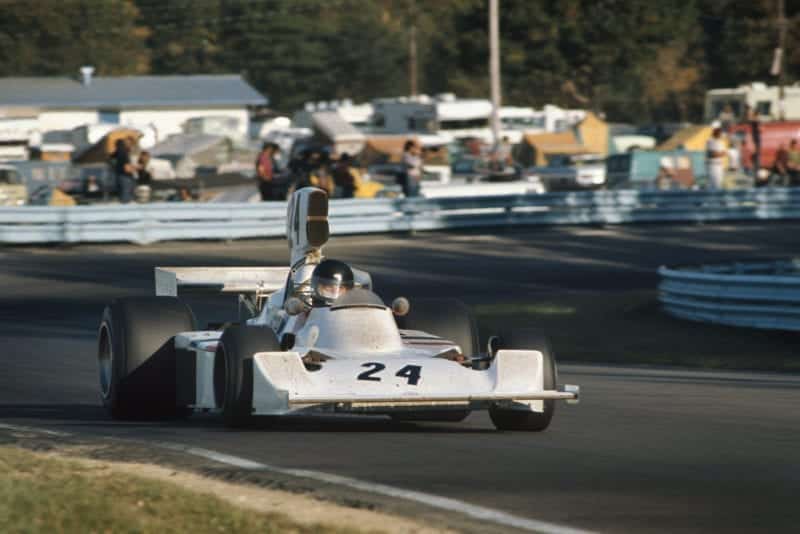
James Hunt finished an impressive 3rd
Motorsport Images
With the first three remaining in the same order and Lauda still keeping the Tyrrell and McLaren behind him, interest was focused on the speed with which Merzario caught Watson and the tenacity with which both Mass and Peterson disposed of Regazzoni’s understeering Ferrari. By lap 15 the Swiss virtually conceded any hope of winning the Championship when he rolled into the pits to complain about his car’s impossible handling. The only solution was felt to replace the front tyres, so the Ferrari was sent back into the race with some fresh rubber at the front only to return later with the same complaint. While the order at the front of this highspeed procession remained very much as one might expect bearing in mind the grid positions, the one “n****r in the woodpile” turned out to be Merzario. By lap 22 he was right on Watson’s tail and challenging the Ulsterman as hard as he knew only to let enthusiasm get the better of his judgement and elbow Watson into a spin three laps later as they jostled for position going into the tight right-hand corner after the pits. Watson “handbrake turned” his Brabham with a dexterity that raised cheers from the crowd, but by the time he was pointing in the right direction, Merzario had vanished into the distance in pursuit of Fittipaldi.
Regazzoni felt his Ferrari handling just as badly within a few laps and, after a second stop to change the front suspension adjustments, charged back into the race and all but knocked Jochen Mass straight out of the contest as the Yardley McLaren lapped his Ferrari on lap 28. At the tail of the field Dolhem’s Surtees TS16 was withdrawn after the accident to Koinigg and Donohue’s race, which had been hampered ever since the opening stages by spongy brakes, ended with a broken rear suspension link on the Penske at the point where it attaches to the bottom of the upright. In bleak contrast to last year’s race, Team Lotus were having an absolutely soul-destroying race. Peterson was fighting his way through the mid-field runners and struggled up to ninth place, his Lotus 72 understeering like mad all the way round the circuit and even the Swede’s brand of determination did not seem enough to overcome the problems on this occasion. In the pits Colin Chapman wore a grim expression on his face for not only had Schenken been hauled off the track, but Ickx had brushed a crash barrier on his seventh lap and driven slowly in to retire with deranged suspension on his 72. But there was plenty more misfortune in store, for the sole surviving 72 suddenly started to sound desperately rough and on the 32nd lap Peterson drove into the pits where it was found that an exhaust pipe had come away from one bank of the DFV right up by the cylinder head.
After a brief checkover he was sent on his way but eventually stopped for good when a fuel line became detached. Whilst all this drama was unfolding for their rival teams, both works Brabhams continued to lap steadily and progressively, Pace taking great chunks out of Hunt’s second place advantage as the race progressed to the lap 45 mark and the Hesketh began to experience fuel-pick-up problems. Encouraged by the obvious plight of his immediate rival, Pace speeded up and established a new Formula One record of I min. 40.6 sec. on lap 54 prior to snatching second place one lap later. From that point on it was all over and the two smart white Brabham BT44s sped confidently on to a convincing 1-2 result at the end of 59 laps’ racing, Reutemann leading Pace over the line by slightly less than 11 seconds.
Hunt dropped away substantially over the final two laps, but he just managed to keep the Hesketh spluttering round for long enough to beat Fittipaldi by five seconds, the Brazilian not taking any chances whatsoever and cruising gently round those final laps to clinch his second World Championship and the very first for McLaren Racing. By sitting on Scheckter’s tail all the way, he knew that the Tyrrell driver had no chance of taking the title, but when the blue car drifted to a standstill with fuel-pick-up problems on lap 45, the contest was all over. It was only left for Watson and Depailler to finish in strong fifth and sixth places, Merzario having stopped his Williams with an electrical fault which discharged the car’s fire extinguisher into his face and then caused the engine to cut out, while Mass had driven very hard from near the back of the grid to take seventh place.
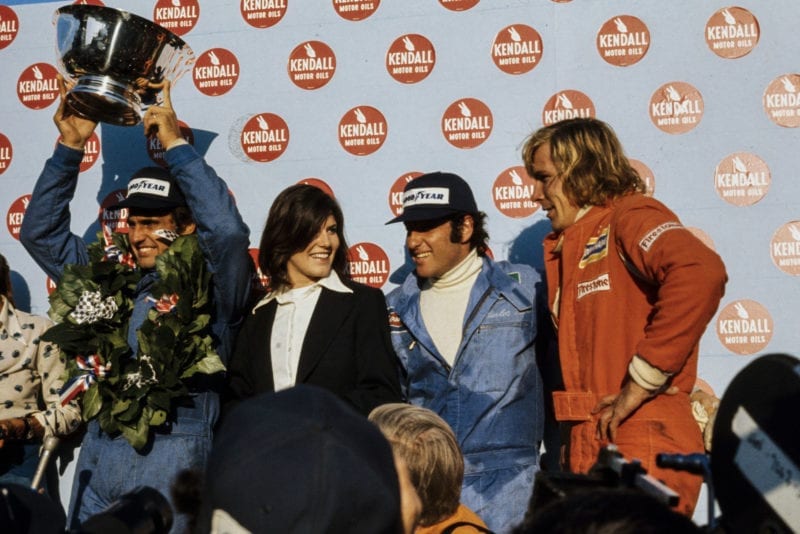
Reutemann (far left) celebrates on the podium
Motorsport Images
It was an excellent result for the works Brabhams, Reutemann having maintained the tremendous form he has shown throughout the second half of the season, but somehow there was a feeling of anti-climax over the way in which the Championship contest had fizzled out. Fittipaldi had driven a conscientious and “strategic” race into fourth place, but it was hardly the stuff of which legends are made, while the failure of Ferrari to maintain their competitive edge proved a rather disappointing footnote to the last race of the year. ––A.H.
